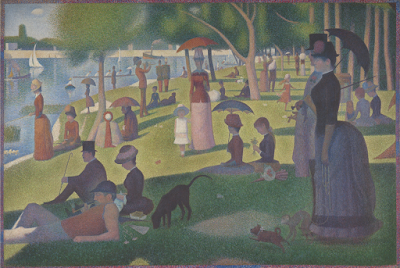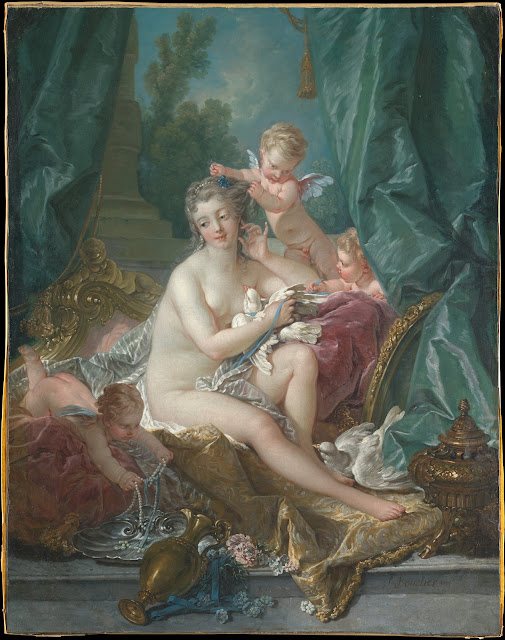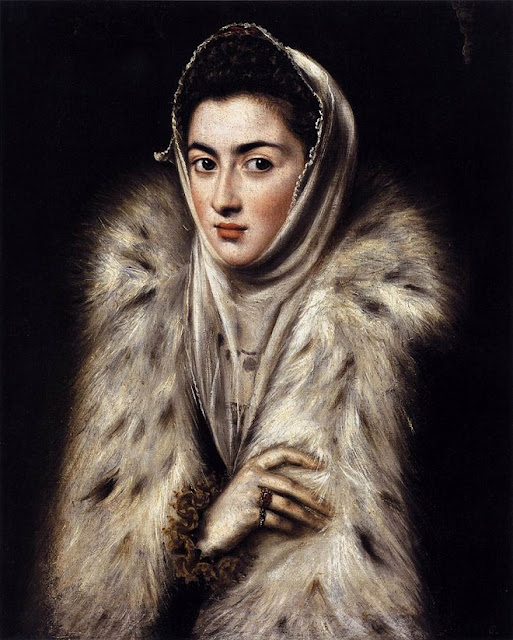Art in a Changing World:
From the early 19th to late 20th centuries several art movements were popularized and then replaced as change swept across the world like never before. Largely due to the Industrial Revolution and the effects it had on the world at large, the rapid pace of growth across every facet of society was monumental. As a reflection of this rapid change the world of art began to take a new shape, as art "for its own sake" was now the modern ideal.
Often referred to by the umbrella term Romanticism, artists of this time were constantly challenging old ideas with fresh ones, and because of this waves of artistic styles washed over society, as if the dams of creativity had finally been open. From the Romantic style to Realism, Post-Impressionism to Art Nouveau, artists working in every medium had near-limitless opportunities to express the world as they saw it.
Post-Impressionism:
Post-Impressionism, a term coined by English art critic Roger Fry in 1910, was the answer to the Impressionist movement. While the artists did not share a unified approach their art was still founded in Impressionism and many great works and styles would emerge from it.
Georges Seurat--
Georges Seurat, "A Sunday Afternoon on the Island of La Grande Jatte", 1884-1886. Oil on canvas, 6'9 1/2" x 10' 1 1/4 " (207 x 308 cm). Art Institute of Chicago. Helen Birch Bartlett Memorial Collection.
One popular artist was Georges Seurat (1859-1891), a painter born in Paris. Using his masterful skills he experimented with hues and tones. His most famous work, "A Sunday Afternoon on the Island of La Grande Jatte" shows many social classes mixing together on a pleasant Sunday. Some subjects relax on the ground, while others stand or walk throughout the painting. This was a common scene in Impressionism and Post-Impressionism alike.
Seurat attempted to show his skills with color and gain attention for his other works, yet this one was to outshine them all.
It's a vibrant piece but sedated, the way Seurat blends color creates a hazy, dreamlike image, making the scene feel distant and aloof. The faces of the subjects are almost non-existent, as was common for the two styles, and the circular shapes round out the dreamy feeling.
Even with the vibrancy of color, I feel very much like an outsider viewing this piece. Seurat chose several complementary colors and demonstrated skill with lighting, making a point to show his mastery of both heavy and light value, but combined with the geometrical forms and the ghost-like faces, the piece is almost unnerving.
It feels more like a nightmare to me than a dreamy idea of well-off locals enjoying their day. As a measure of the artist's skill, it is plainly conveyed well, but I personally don't enjoy this piece.
Paul Gauguin--
Paul Gauguin, The Mango Trees, Martinique, 1887, oil on canvas, 86 × 116 cm (Van Gogh Museum, Amsterdam)
Another artist of the Post-Impressionist movement was Paul Gauguin (1848-1903), who was friends with the well-known Vincent Van Gogh. Like the decidedly more talented painter, Gauguin was relatively unknown during his lifetime and only achieved fame after his death. As much as his work is expressive, the artist's fascination with the "exotic" and the uncomfortable undertone of some of his work is apparent, coloring the feeling for many.
The piece "The Mango Trees, Martinique" is one of the many he did during his time in the Caribbean, and in it he depicts women gathering fruit from trees. The largest figure in the foreground is a porteuse, a word used to describe a woman who carries baskets on her head to move produce around.
The subjects wear traditional clothing painted in muted tones, and the orange and greens of the background painted much more vividly, set them apart.
This piece was a moment in time in the lives of everyday people.
Gauguin's fascination with Martinican and other "ethnic" cultures--namely the women who performed them--was reflective of the feelings of many European men of the time and had many fantastical ideas about them. They expressed this through wildly inaccurate paintings.
As much as this is skillfully done, the overall composition is lacking to me. The entire scene is very flat. The brushstrokes give the illusion of an image at a glance, but there is some emotion lost in the translation. The viewer feels very far away, and I can't tell if this is a moment or an idea of a memory Gauguin had. The value of the piece creates a washed effect, and rather than dreamy it feels uninteresting and faded. There isn't much given away to the personality of the subjects, as if they hardly mattered in the overall picture.
Considering the wealth of paintings done in both Impressionist and Post-Impressionist styles, I feel this piece is very lacking comparatively. For example, Gauguin's friend Van Gogh was not only able to capture his chosen subject matter with a flourish, but he was also able to convey many deep emotions through his work. Van Gogh's scenes are often dreamy or distant, sparking the imagination.
Gauguin, for me, fell short both as a person and an artist.
Art Nouveau:
Another movement during the Romantic period, and what might've been the last of this period, was Art Nouveau, literally "new art". It was a complete rejection of the older styles, and sometimes a slap in the face of established art. From architecture, furniture, and most famously advertisements, Art Nouveau had the fleeting "it factor" during its life.
The movement was short-lived but had a great impact on the many modern styles that came after it. Art Nouveau produced some of the most beautiful pieces of early 20th-century art during a wild but small period of popularity, and it's for this reason we remember it.
Gustav Klimt--
Gustav Klimt, Pallas Athene, 1898, 29.5 x 29.5 in (75 x 75 cm), oil on canvas, Deutch: Historisches Museum der Stadt Wien
Austrian-born Gustav Klimt (1862-1918) is possibly the most well-known artist of the Art Nouveau movement. His work often featured femme fatales and, as was common with the style, used shocking scenes and imagery to convey messages about his conservative society. His fondness for using gold leafing in much of his work likely comes from his father, who engraved gold for a living.
In this oil painting done in 1898, Klimt displays a powerful image of the Greek goddess Athena, wearing golden armor complete with a helmet and golden staff. In her left hand is a small, nude figure which holds a small mirror. Behind her is a classical scene of Hercules battling the sea monster Triton.
This piece is deeply symbolic of the war of ideas between artists such as Klimt and the established, accepted art institutions of his time. The image is powerful, as was Athena, and unlike his more famous femme fatales, there is little overt sexuality in this piece.
The gold leafing was something Klimt worked masterfully in his art, a perfect complement to convey the status of a goddess like Athena. Her distant, stoic expression adds weight to the ethereal feeling, the untouchable beauty of her form both drawing in and repelling the observer.
The piece itself is very dark, which lends to the gold leafing almost jumping off the canvas. The artist shows a powerful perspective, with the background images almost fading in the dark behind Athena.
The forms are both situated in reality and far off as if the image appeared to the observer in a dream.
Klimt's rejection of the establishment is in stark contrast with the studied power of his strokes. Much of his skill came from studying the masters of classical art and mythology, and yet he displays them in an overtly rebellious way.
I love the power and feeling of this piece and its overall message. Athena was a fierce goddess of both war and wisdom, and the parallels Klimt is attempting to convey to his movement are classically defiant.
Alphonse Mucha--
Alphonse Mucha, "Daydream", 1897, color lithograph, 28 5/8 x 21 3/4 in, Mucha Trust Collection, 2021 Mucha Trust.
A Czech artist who lived from 1860-1939, Mucha became wildly popular in the Art Nouveau movement with his art made for advertisements. Many of his pieces depicted beautiful women, and many of his techniques--muted colors, harmonious compositions, etc.--became foundational within the movement. Though he never aligned himself with it, Art Nouveau benefited greatly from his work.
This piece, titled "Daydream", was a lithograph initially designed for use in a calendar. In it, we see a fair-skinned woman, sitting quaintly with a flowing dress and a large book of decorative designs in her arms. Her hair is tied up and adorned with flowers, her very image entirely fantastical. The background features many circular forms with botanical imagery, complete with swirling lines moving all around her.
Though clearly an advertisement, this piece is nonetheless striking in its forthright beauty. The pinks and greens are staples of the Art Nouveau style, creating a solidly feminine energy. The linework in this piece is more cartoonish in execution, but flows together masterfully, again with circular forms that have a distinctly feminine feeling. The woman's expression is one of contentment as if she is having as pleasant a time as we are, he makeup light like the spring-like flowers all around her.
The entire image draws the viewer into a pleasant, dreamy state. It has an appealing aesthetic and designs such as Mucha's truly marked a turn in the way businesses advertised, which can still be observed today in both advertisements and graphic design.
Citations:
“Alphonse Mucha: Art Nouveau Visionary (Exhibition).” Alphonse Mucha: Art Nouveau Visionary – NCMALearn, North Carolina Museum of Art, 2017, learn.ncartmuseum.org/resources/alphonse-mucha-art-nouveau-visionary/.
The Art Tourist, director. Several Circles: Know the Artist: Gustav Klimt. YouTube, YouTube, 13 Jan. 2020, https://www.youtube.com/watch?v=C3HR9vDL8IU. Accessed 29 Oct. 2023.
Dr. Charles Cramer and Dr. Kim Grant, "Art Nouveau," in Smarthistory, June 14, 2020, accessed October 31, 2023, https://smarthistory.org/art-nouveau/.
Foundation, Mucha. “Reverie (1898).” Mucha Foundation, Mucha Foundation, 2023, www.muchafoundation.org/en/gallery/browse-works/object/78.
Gustav Klimt (Künstler), Pallas Athene, 1898, Wien Museum Inv.-Nr. 100686, CC BY 4.0, Foto: Birgit und Peter Kainz, Wien Museum (https://sammlung.wienmuseum.at/objekt/102991/)
Jason. Know the Artist: Alphonse Mucha. Performance by Rachel, YouTube, YouTube, 6 July 2019, https://www.youtube.com/watch?v=7eyn_-Cp59E. Accessed 31 Oct. 2023.
Joost van der Hoeven, ‘Paul Gauguin, The Mango Trees, Martinique, 1887,’ catalogue entry in Contemporaries of Van Gogh 1: Works Collected by Theo and Vincent, Joost van der Hoeven (ed.), Amsterdam: Van Gogh Museum, 2023. doi.org/10.58802/LIRH9345
Seurat, Georges. “A Sunday on La Grande Jatte - 1884.” The Art Institute of Chicago, Painting and Sculpture of Europe, www.artic.edu/artworks/27992/a-sunday-on-la-grande-jatte-1884. Accessed 31 Oct. 2023.







Comments
Post a Comment